It’s a sunny, hot Saturday afternoon on the east coast of Samoa’s most populous island, Upolu. I’m on the grounds of the Piula Theological College, alongside dozens of local families as, in addition to biblical studies, this is the home of the Piula Cave Pool. Fed by a fresh water spring, the large natural swimming hole sits beneath a cliff from which the college’s 1868 church majestically overlooks the scene.
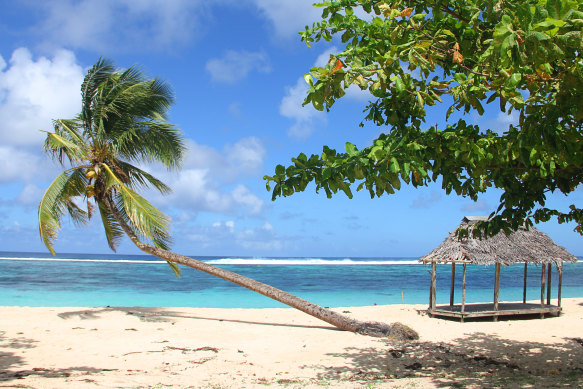
Upolu, the most populous island of Samoa.Credit: iStock
The water in the pool glows and sparkles like an iridescent blue and green opal in an old-fashioned setting of concrete walkways, thatched fales, a kiosk and toilet block.
The families chat and laugh as they splash about or picnic in the shelters, so perhaps don’t notice the visitors sliding into the water. The tourists wade around, smartphones in hand, shooting content for their socials.
I’m sitting in a shelter having a cool drink when I notice the locals fall abruptly quiet. I look up and see the cause: the visitors exiting the pool in barely-there G-string bikinis.
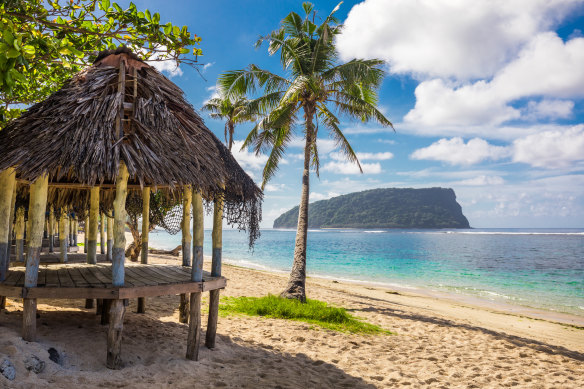
Lalomanu Beach which is, according to Lonely Planet, one of the top 10 beaches in the world. Credit: iStock
There are signs at Samoan swimming spots that stipulate “public decency” rules, one of which concerns bikinis and not wearing them anywhere other than the water. I’ve got no beef with brief swimwear, generally, and you have to get in and out of the water, after all.
But there are obvious sensitivities here that might find trendy Bondi- and Bali-ready swimsuits somewhat confronting, and therein lies the rub.
With its natural attributes, colourful villages and photogenic people, Samoa is the Instagrammable, Tik-Tok-ready unspoiled paradise of a social media maven’s dreams.
This central South Pacific nation comprising two main islands, Upolu and Savai’i, with several smaller satellite islands, is only four hours and 45 minutes’ flight from Brisbane with Virgin Australia. Lying between New Zealand and Hawaii, it is Polynesian by ethnicity. Influenced by missionaries who first arrived in the 1830s, Samoa is therefore devoutly Christian and fundamentally modest.
It is a developing country which, in recent times, has had natural disasters and remains vulnerable. It is just recovering from a pandemic-driven recession and continues to face economic challenges. It is also a country keen to attract more visitors. How then, does it balance visitor expectations with its own?
I’m contemplating this as I have yet another cold shower at Le Uaina Beach Resort, a small family-run property that feels like it is in a tourism time warp. It has absolute ocean frontage, a lovely swimming pool and lush lawns. The food is tasty and the hospitality is warm.
In my large, clean room, the sheets are worn and pilled, the furniture ugly and mismatched and the hot water doesn’t work.
To report the latter, I visit the open-air reception space with decor that harks back to the ’80s, dodging the three large – and placid – stray dogs who are enjoying the cool of the tiles.
“Welcome to Samoa,” the receptionist says in response to my complaint. We laugh together. There will be no hot showers for me.
The capital, Apia, has world-class resorts – which will no doubt be full when CHOGM (Commonwealth Heads of Government Meeting) hits Samoa in October. The iconic Sheraton Samoa Aggie Grey’s Resort & Bungalows is set to reopen in time for it after falling victim to flash flooding in 2020.
There is a smattering of atmospheric boutique properties around the islands – the pretty Le Lagoto Resort & Spa on the north coast of Savai’i, for instance.
There are simple offerings with charm, too, such as the idiosyncratic Dave Parker Eco Lodge, where astonishing views are the reward after negotiating a notoriously steep drive.
But there are also the puzzling ones.
At Taufua Beach Fales my bungalow should have views to die for. It overlooks Lalomanu Beach, which Lonely Planet says is among the top 10 beaches in the world. But if the louvre windows are closed for air-conditioning purposes, you can’t see it. They are made of heavily frosted glass. There’s a lot more that could be said about the puzzling nature of this accommodation, but – welcome to Samoa.
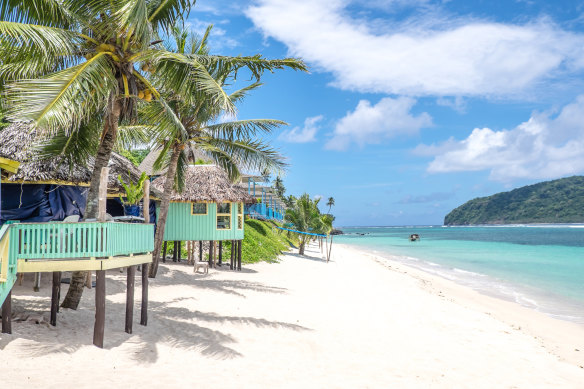
View along Lalomanu Beach of colourful Samoan beach fale huts used as tourist accommodation.Credit: Getty Images
All is (almost) forgiven though because I have the best meal of the trip in the Taufua beachside restaurant which has unhindered views. (And for the adventurous, Taufua has fale accommodation right on the beach, too. It’s basic but the views are box-seat.)
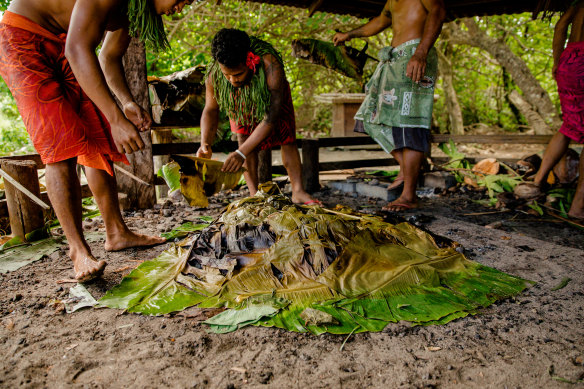
Food is prepared in a traditional umu earth oven in Samoa.
Food at Taufua is delivered “family-style” with guests sharing long tables. It’s home-style Samoan, a mix of meats and root vegetable cooked in an umu, the traditional Samoan earth oven, bastardised Chinese dishes such as chop suey (actually quite delicious) and local curries. The fish is wonderful. It goes well with the water of a coconut, opened to order.
Fresh, simple and local – food is essential to and emblematic of the Samoan way of life. That culture is the aspect of travel in Samoa that, for me, makes any lack of comfort in the accommodation department an easy trade-off. The Samoan people are warm, funny, humble and easy-going – within the boundaries of piety, that is.
Subsistence farming supports them, nutritionally and financially. Bananas, coconuts, breadfruit, chickens, cows and fields of taro and yams flourish against the backdrop of densely foliaged mountains and coral fringed ocean, where fresh seafood is harvested daily.
Among the fields are villages, where even the most basic of homes shows a sense of domestic pride. Surely Samoa is where the Pantone colours of the year go to retire – gaudily painted houses, each with its own thematically coloured open-air fale, are surrounded by neat gardens of exquisite tropical plants and lavish lawns. Old car tyres may also be painted to match the house and put to use as planters; plastic water bottles are strung together and used as fencing.
Everything is beautifully kept. I’m told each village has a women’s committee that comes knocking if a household falls behind on its leaf raking. There are also government incentives to promote pride in village appearance.
Churches are a common village feature, often relatively huge and impressive.
Impressive too, are Samoa’s natural attractions, which you will generally find at a village’s edge. Beaches, swimming holes and waterfalls exist on village-, family- or church-owned land, and you pay the owners for the privilege of visiting – usually WST5 to 20 a person ($2.80 to $12).
The Sauniatu Waterfall, for instance, is within a Mormon village.
A 20-metre cascade cuts through mossy rocks and lush vegetation, feeding an aquamarine swimming hole that catches the light like a faceted jewel. Local kids jump from heart-thumping heights into the cool depths. We pay a security guard on entry.
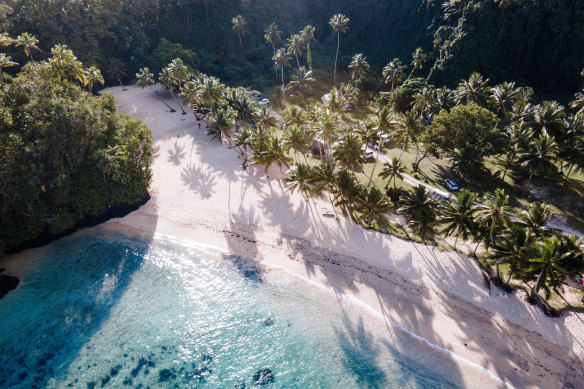
Vavau has a crystal clear lagoon for swimming.
Vavau Beach has a pretty white stretch of sand and broken coral, and a crystal clear lagoon to swim in. It’s first in best dressed for the beach fales – but you might get charged for the pleasure.
To Sua Ocean Trench is perhaps the most photographed of Samoa’s stunning water features. It’s a 30-metre-deep lava hole filled by seawater shining a surreal kaleidoscope of blues and accessed by a long ladder. Its owners have lawned and landscaped the area around it and the charge is WST20 ($11.20) to enter.
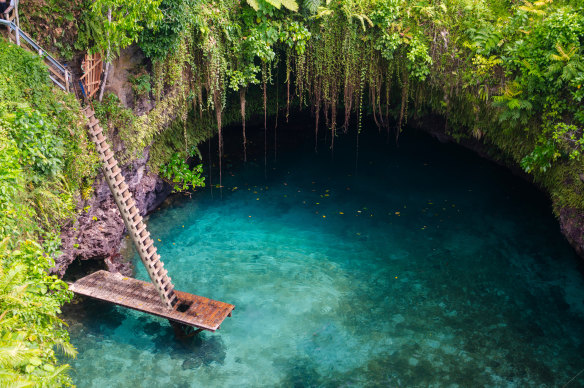
The spectacular To Sua Ocean Trench is reached by a ladder.
And then there’s the kind of attractions you might expect to pay for: the excellent Robert Louis Stevenson Museum, set in the gracious home where the famed Scottish author spent his final years in the late 1800s; the fun and flameful Siva Afi Cultural Show, in which traditionally costumed performers juggle swords and fire as they perform the siva afi dance which originated in Samoa.
There’s not a lot more in the modern sense of “attraction” in Samoa and for many, that is a very big attraction in itself.
It might not be that way forever: there are reports of huge developments planned by foreign interests. And as the adage goes, you can’t stop progress.
For now, though, visitors to Samoa will find a place of traditional Christian and family values, of largely unspoilt landscapes, generous welcomes and a relaxed way of life.
Ah yes, the old “island time” chestnut. One lunchtime, I wait an hour and a half for a burger at a cafe. But as the receptionist said to me at Le Uaina: “welcome to Samoa.”
In other words, as visitors we need to meet Samoa on its terms, not ours. And with a bit of sensitivity and a willingness to leave our fussiness – and some fashion choices – at the Australian airport of our departure, Samoa can certainly be a dream destination.
The writer travelled as a guest of the Samoa Tourism Authority and Virgin Australia. See samoa.travel
The details
Fly
Virgin Australia operates five services a week from Brisbane to Samoa and return, with domestic connections from Sydney and Melbourne. See virginaustralia.com/en-au/flights-to-samoa
Tour
The only way to get around Samoa is by car. The colourful buses you will see around the islands stick to their own localities and don’t connect in any useful way for tourists. There are no trains. There are several car rental companies with offices in Apia and at the airport. The good news is, everything in Upolu is within two hours’ drive of Apia and there’s a car ferry to Savai’i, where distances are longer but still manageable as day trips from accommodation choices.
Stay
Taumeasina Island Resort is one of Samoa’s newest and best appointed properties. It’s close to the centre of Apia, on a man-made private island with road access. It has 80 hotel rooms and 37 two- and three-bedroom villas which have kitchens and Euro laundries. With a lively bar, two restaurants and ample parking, it’s an excellent base from which to explore Samoa. There are two rooms suitable for those with disabilities. From WST600 ($333) a night. Sheraton Samoa Beach Resort is an upscale stay very close to Faleolo International Airport. With a private beach, lagoon swimming pool and open-air restaurant, it’s a great option for the night before an early flight out. It’s closed for pre-CHOGM renovations but will open again in October. From WST454 ($250) a night. See taumeasinaislandresortsamoa.com ; marriott.com
More
samoa.travel
Five other island paradises with cultural sensitivities
Fiji
Even this highly developed, in tourism terms, South Pacific hotspot has its local mores. Respect elders, wear modest clothing (cover knees and shoulders) when outside resorts, particularly on village visits and bend to “island time”.
Tiwi Islands
A fascinating First Nations community awaits across the water from Darwin, but before you post anything about your trip on social media, consider locals may find that offensive. Always seek permission before shooting photos and video.
Maldives
The Maldives has cultural and social sensitivities in line with being a Muslim nation. When planning travel outside resorts, research limitations on swimwear, alcohol consumption and other touchstones.
Flores
With the majority of its population identifying as Catholic, Flores is quite different, in a religious sense, to the rest of Indonesia. But like most of Indonesia, modest clothing with shorts and T-shirts as swimming attire is recommended. Be mindful of cultural monuments and be prepared to remove shoes for entry into certain places.
Phuket
Thailand’s heaving tourism hotspot might seem to be overrun with Westerners but it still has its local customs – don’t criticise the royal family, don’t flip your middle finger, bow your head when greeting monks and elders and cover up at temples.